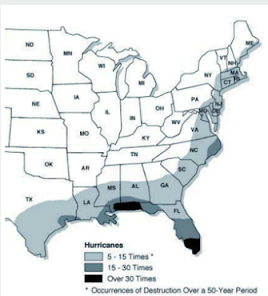A couple of days later (Aug. 6th) NOAA issued their own - equally aggressive - mid-season outlook.
Both forecasts suggest the next two to three months will be extremely active, with anywhere from 10 to 15 additional named storms, with 9 to 10 of those becoming hurricanes. While they can't tell us who will get hit - and hopefully many of these storms will stay out to sea - the odds favor several hurricanes impacting land.
The release from NOAA follows. Follow the link to read it in its entirety (or listen to the teleconference). I'll have more when you return.
'Extremely active' hurricane season possible for Atlantic Basin
NOAA urges preparedness as we enter peak months for hurricane development
Audio file from August 6 media teleconference
August 6, 2020
Atmospheric and oceanic conditions are primed to fuel storm development in the Atlantic, leading to what could be an “extremely active” season, according to forecasters with NOAA’s Climate Prediction Center, a division of the National Weather Service. Today, the agency released its annual August update to the Atlantic Hurricane Season Outlook, initially issued in May.
The 2020 Atlantic hurricane season has been off to a rapid pace with a record-setting nine named storms so far and has the potential to be one of the busiest on record. Historically, only two named storms form on average by early August, and the ninth named storm typically does not form until October 4. An average season produces 12 named storms, including six hurricanes of which three become major hurricanes (Category 3, 4, or 5).
“This is one of the most active seasonal forecasts that NOAA has produced in its 22-year history of hurricane outlooks. NOAA will continue to provide the best possible science and service to communities across the Nation for the remainder of hurricane season to ensure public readiness and safety,” said U.S. Secretary of Commerce Wilbur Ross. “We encourage all Americans to do their part by getting prepared, remaining vigilant, and being ready to take action when necessary.”
The updated outlook calls for 19-25 named storms (winds of 39 mph or greater), of which 7-11 will become hurricanes (winds of 74 mph or greater), including 3-6 major hurricanes (winds of 111 mph or greater). This update covers the entire six-month hurricane season, which ends Nov. 30, and includes the nine named storms to date.
Although I urge hurricane (and general disaster) preparedness every year in this blog (see #Natlprep: Because Disasters Happen) - this year, perhaps more than any in recent memory - is the year you want to be prepared for the unexpected.
Not only are supply chains already under strain due to the pandemic - making prepping more difficult - but relief efforts (FEMA, restoration of water & power, etc.) may be slower in coming after any major disaster.
Hurricane/Tropical Storm Isaias left millions of people in the Carolinas and mid-Atlantic states without power 5 days ago, and hundreds of thousands are still sitting in the dark. The storm spawned more than 100 tornadoes, and killed at least 13 people.
While never a strong hurricane, much of this damage occurred after it was downgraded to a tropical storm. It doesn't take a CAT 5 storm to upend your life.
The old advice that you should have `72 hours' worth of food and water for your entire family (and pets) is woefully inadequate. Most agencies now recommend a minimum of 7 to 10 days (see 7 Days Without A Disaster Kit Makes One Weak) and would encourage those who can, to have more.
The tropics are relatively quiet right now, and may remain so for another week or two. The most active period historically runs from mid-August to mid-October.
All of which means if you live anywhere in the shaded area of the map (below), or anywhere in the Caribbean, you still have time to prepare for the next storm. Even those who live hundreds of miles further inland can be impacted by flooding and tornadoes, and should be preparing as well.
From Escambia County Hurricane Preparedness Information
So, if you haven't already done so, plan a visit to NOAA's Weather-Ready Nation 2020's Hurricane Preparedness week web page, and decide what you need to do now to keep you, your family, and your property safe during the months ahead.
- A battery operated NWS Emergency Radio to find out what was going on, and to get vital instructions from emergency officials
- A decent first-aid kit, so that you can treat injuries
- Enough non-perishable food and water on hand to feed and hydrate your family (including pets) for the duration
- A way to provide light when the grid is down.
- A way to cook safely without electricity
- A way to purify or filter water
- A way to stay cool (fans) or warm when the power is out.
- A small supply of cash to use in case credit/debit machines are not working
- An emergency plan, including meeting places, emergency out-of-state contact numbers, a disaster buddy, and in case you must evacuate, a bug-out bag
- Spare supply of essential prescription medicines that you or your family may need
- A way to entertain yourself, or your kids, during a prolonged blackout
Hurricane Preparedness Week: Day 7 - Complete A Written Plan
Hurricane Preparedness Week: Day 6 - Help Your Neighbors
Hurricane Preparedness Week: Day 5 - Strengthen Your Home
Hurricane Preparedness Week: Day 4 - Get An Insurance Check-up
Hurricane Preparedness Week: Day 3 - Assemble Disaster Supplies
Hurricane Preparedness Week: Day 2 - Develop An Evacuation Plan
National Hurricane Preparedness Week: Day 1 - Determine Your Risk
Hurricane Preparedness Week 2020

